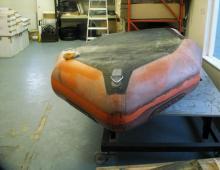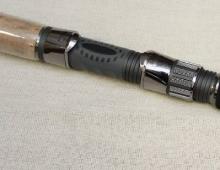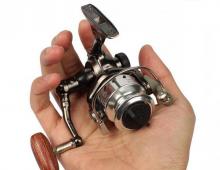A practical guide on how to make a feeder tackle
In stock, fishermen have a large arsenal of ways to fish with a bait. One way is feeder fishing, invented by English fishermen.
The feeder tackle is a donkey, but in an improved version. Unlike the donkey, there is a feeder with bait at the end of the tackle, casting occurs with the help of a rod at a distance three times greater.
Separate elements assembled in a certain order as a whole will make up the feeder tackle.
Depending on the method of attachment and the feeder, there are several types of gear:
- Gardner rig or paternoster.
- Asymmetrical loop.
- With sliding feeder.
All feeder gears have elements that are identical in meaning and purpose, but of different types and sizes, as well as the method of fastening:
- rod;
- coil;
- fishing line or braided line;
- feeder;
- leashes with hooks;
What kind of fish can be used to catch?
Feeder gear is used for catching river and pond non-predatory white fish, for example, carp, carp, crucian carp, roach, bream, silver bream, podust. Sometimes a predator is caught - perch, chub.
Rarely, but it happens, a pike comes across. Feeder tackle allows you to fish far from the shore. There, the fish are calmer and not afraid to take the bait, in contrast to the proximity to the shore or boat.
Types of feeder equipment

For a small pond, you can use a slow or medium action rod with a length of 3.3 meters and a test of 40-60 grams.
The activity of fish biting and the catch depends on the correctly selected equipment and the manufacture of gear.
The rod is specially designed for feeder fishing. It features a large number of rings and a replaceable tip.
But you can also use ordinary spinning rods. The rod is selected depending on the reservoir where the fishing will take place.
For a large body of water and a fast river, a fast action rod up to 3.9 meters long and with a test of 100-120 grams is suitable.
The build will depend on the size of the fish. Slow action is more sensitive to small fish.
The reel is used inertialess, since with its help long-distance casts are obtained, which is important for feeder fishing.
The fishing line is taken with a thickness of 0.2–0.3 mm. It is better to use a braid with a diameter of 0.12–0.14 mm.
Leashes are prepared from fishing line with a thickness of 0.18–0.2 mm, from 20 to 60 centimeters long. Bells or electronic bite alarms can be used as a signaling device.
Feeders come in a variety of sizes and weights. Its weight must not exceed the second number in the rod test. By type, the feeders are in the form of cells, spirals, cones with a shifting load. There are no special requirements for their choice. Each fisherman selects the type of feeder individually.
Before throwing the feeder with top dressing, it is necessary to study the bottom of the reservoir. Instead of a feeder, attach a lead weight of 40 grams, and, throwing it in different places, try to study the bottom. Only after that you can start casting the feeder with bait.
When buying a feeder, there are two things to consider:
- Purchase them weighing no more than the rod test indicated.
- Have two pieces in stock, as sometimes there are hooks and breaks in the feeders.
- Do not spend money on the purchase of ready-made feeder gear, but purchase only individual elements.
How to increase the catch of fish?

For 7 years of active passion for fishing, I have found dozens of ways to improve the bite. Here are the most effective ones:
- Biting activator. This pheromone additive lures fish the most in cold and warm water. .
- Raise gear sensitivity. Read the appropriate manuals for the particular type of tackle.
- Lures based pheromones.
Do-it-yourself feeder tackle
In the manufacture of gear there are no difficulties. It is necessary to purchase components in the store - feeders, hooks, fishing line, rod with a reel. You can make tackle directly at the reservoir with your own hands in a few minutes. From the tool you only need a knife or scissors for cutting the fishing line.
The main thing in feeder fishing is to make the right tackle.

This is the simplest rig.
It is done on the main line:
- At a distance of 30 centimeters from the end of the main fishing line, a loop 15 centimeters long is made. A feeder is attached to it.
- A small loop is made at the end of the line.
- A leash with a hook is made from fishing line with a diameter of 0.18 mm and a length of 60 centimeters. It is attached to a small loop in a loop in a loop. The tackle is ready.
 A symmetrical loop is prepared on a separate piece of fishing line 1.5 meters long and 0.25 mm thick:
A symmetrical loop is prepared on a separate piece of fishing line 1.5 meters long and 0.25 mm thick:
- The line folds in half.
- At the bend, a small loop is made for the leash.
- After 10 centimeters from the loop, we tie both ends with a strong knot.
- After another 30 centimeters, we once again firmly tie both ends of the fishing line. A feeder will be attached to the resulting large loop.
- Cut off one end.
- At the second end of the line, 15 centimeters from the knot that is connected to the main line.
An asymmetric loop is made as symmetrical, but point number 4 changes. One end is 35 centimeters long, and the other 25 is firmly connected to each other. A feeder is attached to the long side of the resulting loop. Further like a symmetrical loop.

An anti-twist tube is put on the main line, then a bead. A swivel is attached to the end of the fishing line, to which the leash is attached. The feeder is attached to the anti-twist.

Similar to the previous tackle, only instead of an anti-twist tube, a feeder is strung. A pellet is placed above the feeder, limiting its movement.
fishing technique
Placed on the shore, on which rods are installed horizontally and parallel to the shore, or vertically at an angle of 70 degrees to the water.
The fishing technique consists of several stages:
- Bait is placed in the feeder of the collected tackle.
- Bait is put on the hooks.
- The rod is taken with two hands, wound over the shoulder behind the back.
- The fishing line near the reel is fixed with the index finger of the right hand (for a right-hander).
- The coil bail is removed.
- A throw is made from behind the shoulder in the direction of a pre-selected direction.
- When the feeder falls to the bottom, put the rod on, wind up the fishing line to tension.
- Attach a bell or an electronic bite alarm to the tip of the rod.
- When a fish bites, you will see the bending of the rod tip, the ringing of a bell or the sound of a buzzer.
- It remains to hook and pull the fish.
- In order to throw the feeder several times in one direction, you need to select a landmark on the opposite bank and aim at it.
- So that when playing the feeder does not cling to the bottom of the reservoir, you need to make a small wing measuring 7 cm by 2, which is cut out of a plastic bottle. Four holes are made along the longitudinal axis at the same distance. A fishing line is threaded through them, and the wing is placed at a distance of 20-30 cm from the feeder.
- With a rare bite, cast after 15 minutes.
- Do not make sharp jerks when casting gear. This can lead to rod breakage.



